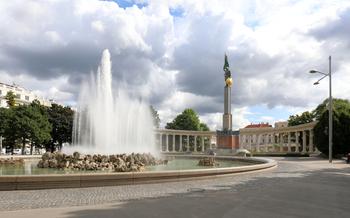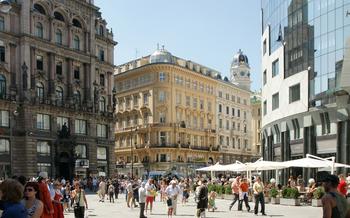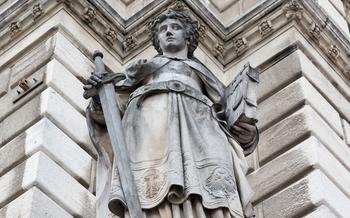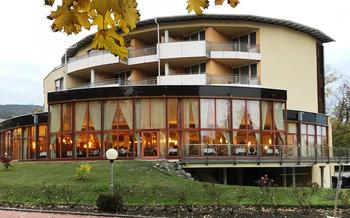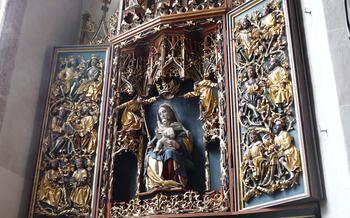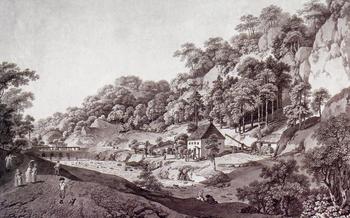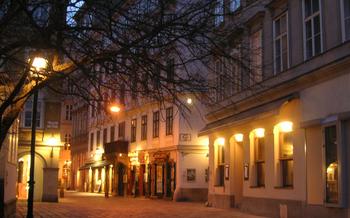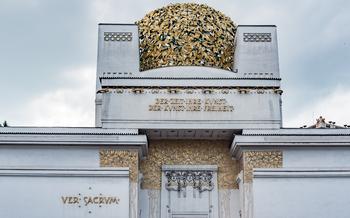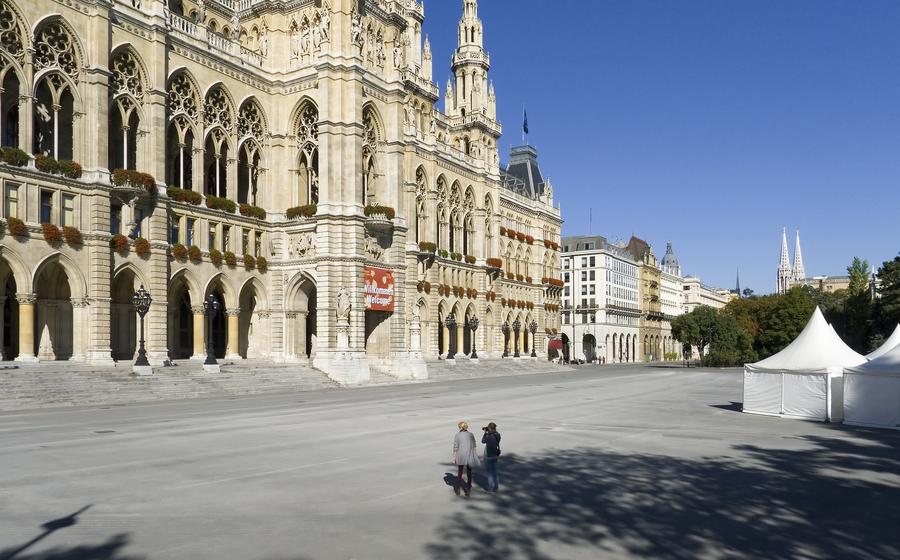
Rathausplatz
- The Rathausplatz: A Vibrant Heart of Vienna
- Rathaus: An Architectural Masterpiece
- Rathauspark: A Green Oasis in the Heart of Vienna
- Burgtheater: A Theatrical Gem
- Parliament Building: A Symbol of Democracy
- Natural History Museum: A Realm of Wonders
- Kunsthistorisches Museum: A Treasure Trove of Art
- Museumsquartier: A Cultural Hub
- MQ Libelle: A Unique Rooftop Experience
- Shopping on Mariahilfer Straße
- Naschmarkt: A Culinary Adventure
- Karlskirche: A Baroque Masterpiece
- Secession Building: A Symbol of Art Nouveau
- Insider Tip: Vienna City Card
The Rathausplatz: A Vibrant Heart of Vienna
The Rathausplatz, or Town Hall Square, is a bustling hub of activity in the heart of Vienna. Steeped in history and surrounded by architectural landmarks, it exudes a festive atmosphere and plays host to a variety of cultural events throughout the year.
The Rathausplatz is home to the Rathaus, or Town Hall, a magnificent neo-Gothic masterpiece that dominates the square. Its intricate details and historical significance make it a must-see attraction. The square is also home to the Rathauspark, a tranquil green oasis that offers a respite from the city's hustle and bustle.
The Rathausplatz comes alive during festive occasions, with Christmas markets, concerts, and public gatherings filling the air with joy and excitement. Whether you're a history buff, an architecture enthusiast, or simply seeking a vibrant atmosphere, the Rathausplatz is a must-visit destination in Vienna.
Rathaus: An Architectural Masterpiece
The Rathaus, or City Hall, stands as a testament to Vienna's architectural prowess. Its Gothic Revival style, characterized by intricate details and soaring spires, is a sight to behold. The Rathaus's facade is adorned with sculptures and carvings that depict historical figures and scenes from Viennese history.
Inside, the Rathaus boasts grand halls and chambers, each with its own unique character. The Gemeinderatssaal, or Council Chamber, is the most impressive of these, with its high vaulted ceiling, ornate chandeliers, and stained glass windows. The Rathaus also houses the Vienna City Museum, which chronicles the city's rich history through interactive exhibits and artifacts.
Guided tours of the Rathaus are available, providing visitors with an in-depth look at its history, architecture, and significance. These tours offer a chance to learn about the building's construction, its role in Viennese politics, and the artwork that adorns its walls. Whether you're an architecture enthusiast or simply looking to explore one of Vienna's most iconic landmarks, a visit to the Rathaus is a must.
Rathauspark: A Green Oasis in the Heart of Vienna
Amidst the bustling streets of Vienna's city center, the Rathauspark offers a tranquil retreat for relaxation and rejuvenation. Designed in the 19th century, this sprawling park is a testament to Vienna's commitment to preserving green spaces within its urban landscape.
As you step into the park, you are greeted by a tapestry of manicured gardens, vibrant flowerbeds, and towering trees. The park's layout is a skillful blend of formal and informal elements, creating a harmonious balance between structured landscaping and natural wilderness.
Statues and fountains dot the park, adding a touch of elegance and whimsy to the surroundings. The most notable fountain is the Rathauspark Fountain, an elaborate water feature that cascades into a serene pool, providing a soothing backdrop for leisurely strolls.
The Rathauspark is not merely a place of beauty; it is also a vibrant hub of activity. During the warmer months, the park comes alive with outdoor concerts, theater performances, and art exhibitions, attracting both locals and tourists alike.
For those seeking a tranquil spot to unwind, the park offers numerous benches and secluded corners where you can escape the hustle and bustle of the city and immerse yourself in the beauty of nature. Whether you prefer to read a book, enjoy a picnic, or simply soak up the sun, the Rathauspark provides an idyllic setting for relaxation and contemplation.
Burgtheater: A Theatrical Gem
Nestled within the Rathausplatz's cultural tapestry, the Burgtheater stands as a beacon of theatrical excellence. Its grand neo-Renaissance facade, adorned with intricate carvings and sculptures, beckons visitors to step into a world of artistic enchantment.
Founded in 1741 by Empress Maria Theresa, the Burgtheater has a rich history deeply intertwined with the cultural heritage of Vienna. For over two centuries, its stage has showcased a dazzling array of theatrical productions, from classical masterpieces to groundbreaking contemporary works.
Beyond its historical significance, the Burgtheater is renowned for its architectural beauty. The auditorium, with its opulent red velvet seats, gilded balconies, and intricate ceiling frescoes, creates an atmosphere of grandeur and elegance.
The Burgtheater's reputation for excellence extends far beyond its physical splendor. It boasts a world-renowned ensemble of actors and directors, who bring to life unforgettable performances that have captivated audiences for generations. From the works of Shakespeare and Schiller to modern plays by contemporary playwrights, the Burgtheater's repertoire is as diverse as it is acclaimed.
For those seeking a deeper dive into the theater's history and inner workings, guided tours are available, offering a glimpse behind the scenes and insights into the artistic process that brings the magic of theater to life.
Parliament Building: A Symbol of Democracy
At the heart of Vienna's Ringstraße, stands the majestic Parliament Building, a grand edifice that serves as the seat of the Austrian Parliament. This Neo-Gothic masterpiece, completed in 1883, is a powerful symbol of democracy and a testament to Vienna's rich architectural heritage.
The Parliament Building exudes grandeur with its intricate facade, adorned with sculptures, gargoyles, and delicate tracery. Its towering central dome, a defining feature of Vienna's skyline, symbolizes the nation's sovereignty. Inside, the building is equally impressive, with a series of grand halls and chambers, each adorned with exquisite artwork and historical artifacts.
Guided tours of the Parliament Building offer a glimpse into the fascinating history and inner workings of Austria's democratic system. Visitors can explore the impressive debating chamber, where parliamentarians engage in lively discussions and debates, shaping the nation's policies. The tours also provide insights into the building's architectural highlights, revealing hidden details and stories that bring the building's history to life.
For those interested in witnessing the Austrian Parliament in action, debates and sessions are open to the public, allowing visitors to observe the democratic process firsthand. These sessions provide a unique opportunity to witness the vibrant political discourse that shapes the future of Austria.
Natural History Museum: A Realm of Wonders
Journey into the Fascinating World of Nature and Science
Nestled within the vibrant cultural hub of Vienna, the Natural History Museum stands as a testament to the wonders of nature and the pursuit of scientific knowledge. Step inside this grand institution and embark on an extraordinary journey through the annals of life on Earth, from the tiniest microorganisms to the colossal giants that once roamed our planet.
A Treasure Trove of Exhibits
The Natural History Museum boasts a vast and diverse collection of exhibits, offering visitors an unparalleled glimpse into the intricate workings of the natural world. Explore the awe-inspiring Hall of Dinosaurs, where life-sized replicas of these prehistoric behemoths, such as the towering Tyrannosaurus Rex and the Triceratops, seem to come alive before your eyes. Marvel at the meticulously preserved fossils, providing a tangible connection to the Earth's distant past.
Interactive Displays for All Ages
The museum's commitment to engaging and interactive exhibits makes it a captivating destination for visitors of all ages. Delve into the mysteries of the deep sea in the captivating Marine Life exhibit, where life-like models of aquatic creatures swim gracefully through their underwater habitats. Immerse yourself in the immersive Mineral World display, showcasing the stunning diversity and beauty of Earth's geological treasures.
Unraveling the Secrets of Life
Venture through the captivating Hall of Evolution and trace the remarkable journey of life's origins and diversification. Discover the intricate connections between species, from the humble beginnings of single-celled organisms to the extraordinary complexity of human evolution. Learn about the forces that have shaped the Earth's biodiversity and the challenges facing our planet's ecosystems.
Guided Tours for In-Depth Exploration
To delve deeper into the museum's vast collection and gain insights from expert naturalists, join one of the guided tours offered throughout the day. These informative sessions provide a comprehensive overview of the museum's highlights and allow visitors to ask questions and engage in discussions about the wonders of the natural world.
Kunsthistorisches Museum: A Treasure Trove of Art
Immerse yourself in the world's finest art collection at the Kunsthistorisches Museum (Art History Museum). This magnificent museum, located in Vienna's Museum Quarter, houses a treasure trove of masterpieces from various eras and cultures. The museum's collection spans from ancient Egyptian and Greek artifacts to paintings and sculptures from the Renaissance and Baroque periods.
Marvel at iconic works of art by such masters as Raphael, Titian, and Velázquez. Gaze upon the intricate details and vibrant colors of their paintings, capturing the essence of the human experience. The museum also boasts an impressive collection of sculptures, including masterpieces from Michelangelo and Bernini, showcasing the mastery and artistry of these renowned sculptors.
Explore the museum's vast collection of decorative arts, including furniture, tapestries, and jewelry. These exquisite pieces offer a glimpse into the lifestyles and craftsmanship of different periods, providing a deeper understanding of the artistic heritage of various cultures.
Take advantage of the museum's audio guides or join a guided tour to delve into the history and significance of the artworks. Learn about the techniques and influences that shaped the creative process of these master artists, gaining a deeper appreciation for their contributions to the world of art.
Museumsquartier: A Cultural Hub
In the heart of Vienna's vibrant cultural scene, the Museumsquartier, or MQ, stands as a testament to the city's rich artistic heritage. This sprawling complex, once the imperial stables, now houses a diverse array of museums and galleries, each dedicated to preserving and showcasing the finest works of art from around the world.
The Leopold Museum, a must-visit for art enthusiasts, boasts an impressive collection of Austrian art from the late 19th and early 20th centuries, including masterpieces by Gustav Klimt, Egon Schiele, and Oskar Kokoschka.
The MUMOK, or Museum of Modern Art, offers a journey through the evolution of modern and contemporary art, featuring works by Andy Warhol, Pablo Picasso, and Friedensreich Hundertwasser.
The Architekturzentrum Wien, or AzW, is a haven for architecture aficionados, showcasing groundbreaking designs and architectural models from around the world.
Don't miss the MQ Libelle, a rooftop terrace perched atop the Museumsquartier, offering breathtaking panoramic views of the city and serving as a vibrant hub for events, exhibitions, and cultural gatherings.
MQ Libelle: A Unique Rooftop Experience
Perched atop the Museumsquartier, the MQ Libelle offers a unique rooftop experience with breathtaking panoramic views of Vienna. This stylish rooftop terrace invites you to unwind and soak in the city's vibrant energy. Whether you're seeking relaxation or a memorable evening out, the MQ Libelle has something to offer.
As you step onto the terrace, you'll be mesmerized by the stunning vistas that unfold before you. The city's iconic landmarks, including the Rathaus, Parliament Building, and St. Stephen's Cathedral, form a picturesque backdrop that will leave you in awe. As the sun begins to set, the sky transforms into a canvas of vibrant colors, creating a magical ambiance that's perfect for capturing Instagram-worthy moments.
The MQ Libelle boasts a cozy café and bar, where you can indulge in delicious refreshments while enjoying the stunning views. Sip on expertly crafted cocktails, savor a glass of Austrian wine, or treat yourself to a sweet treat as you soak in the vibrant atmosphere.
Throughout the year, the MQ Libelle hosts a variety of events and exhibitions that cater to diverse interests. From art installations and live music performances to pop-up markets and film screenings, there's always something exciting happening at this rooftop venue. Be sure to check the MQ Libelle's website for upcoming events and plan your visit accordingly.
As the day draws to a close, the MQ Libelle transforms into an enchanting sunset spot. As the sun dips below the horizon, the sky bursts into a kaleidoscope of colors, casting a warm glow over the city. Whether you're sharing this magical moment with a loved one or simply relishing the solitude, the MQ Libelle offers an unforgettable experience that will stay with you long after your visit.
Shopping on Mariahilfer Straße
Mariahilfer Straße, also known as Mahü, is one of the longest and most popular shopping streets in Vienna. Stretching from the Museumsquartier to the Westbahnhof, it's a vibrant hub of fashion, accessories, and souvenirs. Department stores like Gerngross and Peek & Cloppenburg stand alongside boutiques and specialty shops, offering a diverse range of goods.
The street is particularly known for its fashion scene, with both local and international brands represented. From high-end boutiques to affordable chain stores, there's something to suit every taste and budget. Whether you're looking for the latest trends, unique vintage pieces, or traditional Austrian souvenirs, you're sure to find it on Mariahilfer Straße.
In addition to shopping, the street is also home to several cafés, restaurants, and bars, making it a great place to take a break and people-watch. The lively atmosphere and diverse crowd add to the overall charm of this iconic shopping destination.
Insider tip: If you're looking for a specific item or brand, be sure to do some research beforehand to identify the stores that carry it. This will save you time and ensure that you don't miss out on any must-visit shops.
Naschmarkt: A Culinary Adventure
Vienna's Naschmarkt is a vibrant and diverse market that offers a culinary journey through various cultures and cuisines. Located in the heart of the city, this bustling marketplace is a sensory delight, where the air is filled with the enticing aromas of fresh produce, spices, and international delicacies.
At the Naschmarkt, you'll find an array of stalls and shops selling everything from fresh fruits and vegetables to exotic spices, cheeses, and meats. Whether you're looking for ingredients to cook a delicious meal or simply want to sample some local specialties, the Naschmarkt has something for everyone.
In addition to fresh produce, the market also offers a variety of international cuisines. From traditional Austrian dishes to Middle Eastern delights and Asian specialties, there's no shortage of options to satisfy your cravings. Whether you prefer to grab a quick bite at a food stall or sit down for a leisurely meal at one of the many restaurants, the Naschmarkt offers a culinary experience like no other.
One of the highlights of the Naschmarkt is its vibrant atmosphere. The market is always buzzing with activity, as locals and tourists alike come together to shop, eat, and socialize. The air is filled with the sounds of vendors calling out their wares, the laughter of friends and families, and the clinking of glasses as people enjoy a drink or two.
If you're looking for a truly authentic Viennese experience, be sure to visit the Naschmarkt. This vibrant marketplace is a feast for the senses, where you can indulge in delicious food, soak up the local atmosphere, and experience the true spirit of Vienna.
Karlskirche: A Baroque Masterpiece
Nestled amidst the vibrant atmosphere of Vienna's bustling cityscape, the Karlskirche stands as a testament to the grandeur of Baroque architecture. With its imposing dome, soaring columns, and intricate facade, this awe-inspiring edifice is a true masterpiece of 18th-century ecclesiastical design.
Conceived by the brilliant mind of Johann Bernhard Fischer von Erlach, the Karlskirche was commissioned by Emperor Charles VI as a symbol of gratitude for the end of a devastating plague that swept through Vienna in 17Dedicated to Saint Charles Borromeo, the patron saint of the Habsburg dynasty, the church's construction spanned over two decades, leaving an indelible mark on the city's architectural landscape.
The exterior of the Karlskirche is a symphony of Baroque elements, characterized by its dramatic interplay of curves and straight lines. The towering columns, adorned with intricate carvings and sculptures, support a majestic entablature that seamlessly transitions into the sweeping dome. The facade is further embellished with an array of statues and reliefs, each meticulously crafted to convey a biblical narrative or allegorical message.
The interior of the Karlskirche is equally captivating, showcasing a harmonious blend of Baroque opulence and sacred serenity. The nave, with its soaring height and intricate stucco work, draws the eye towards the grand altar, a masterpiece of marble, gilding, and intricate carvings. The dome, adorned with stunning frescoes depicting scenes from the life of Saint Charles Borromeo, creates an ethereal atmosphere that invites contemplation and awe.
Guided tours of the Karlskirche provide visitors with a deeper understanding of its rich history, symbolism, and architectural significance. These tours offer exclusive access to hidden corners of the church, such as the crypt, where members of the Habsburg dynasty are interred, and the rooftop terrace, which offers panoramic views of Vienna's cityscape.
Whether you are a devout pilgrim, an art enthusiast, or simply a curious traveler, the Karlskirche stands as an unmissable destination, inviting you to immerse yourself in its Baroque splendor and experience the spiritual and cultural heritage that Vienna holds dear.
Secession Building: A Symbol of Art Nouveau
The Secession Building stands as a remarkable gem of Art Nouveau architecture, proudly situated on Wien's grand Ringstraße. This iconic structure, designed by the renowned architect Joseph Maria Olbrich, was completed in 1898 and served as the exhibition hall for the Vienna Secession, a group of progressive artists who sought to break away from traditional artistic conventions.
The building's striking façade is adorned with intricate metalwork and mosaic tiles, showcasing the essence of the Art Nouveau style. The golden dome, topped with a laurel wreath, is a symbol of the group's aspirations and serves as a beacon of creativity.
Inside, the Secession Building houses a variety of exhibition spaces, showcasing works by both Austrian and international artists. The most notable highlight is Gustav Klimt's masterpiece, the "Beethoven Frieze," which adorns the walls of the main exhibition hall. This monumental work of art, created between 1901 and 1902, is a visual representation of Beethoven's Ninth Symphony and a testament to Klimt's artistic genius.
Beyond its artistic significance, the Secession Building also played a crucial role in shaping Viennese cultural history. It served as a platform for groundbreaking exhibitions, lectures, and discussions, fostering a vibrant intellectual and artistic exchange. Today, the building continues to host a diverse range of exhibitions, events, and guided tours, inviting visitors to delve into the world of Art Nouveau and appreciate its lasting impact on the Viennese art scene.
Insider Tip: Vienna City Card
If you plan to explore Vienna's many attractions and museums, consider purchasing the Vienna City Card. This card offers a range of benefits, including discounted admission to many top attractions, including the Rathaus, Burgtheater, and Natural History Museum. It also provides unlimited travel on Vienna's public transportation network, making it easy to get around the city.
The Vienna City Card is available in different durations, ranging from 24 hours to 72 hours, and can be purchased online or at tourist information centers in Vienna. Prices start from €17 for a 24-hour card and can provide significant savings, especially if you plan to visit multiple attractions.
To make the most of your Vienna City Card, plan your itinerary in advance and identify the attractions you want to visit. The card also includes a guidebook with information on participating attractions and transportation routes, making it easy to navigate the city and make the most of your time.
In addition to saving money, the Vienna City Card offers convenience and flexibility. With unlimited public transportation, you can easily hop on and off trams, buses, and the metro to explore different parts of the city without worrying about buying tickets or fares.
Whether you're a first-time visitor or a seasoned traveler, the Vienna City Card is a great way to experience the city's cultural and historical treasures while saving money and enjoying hassle-free transportation.
